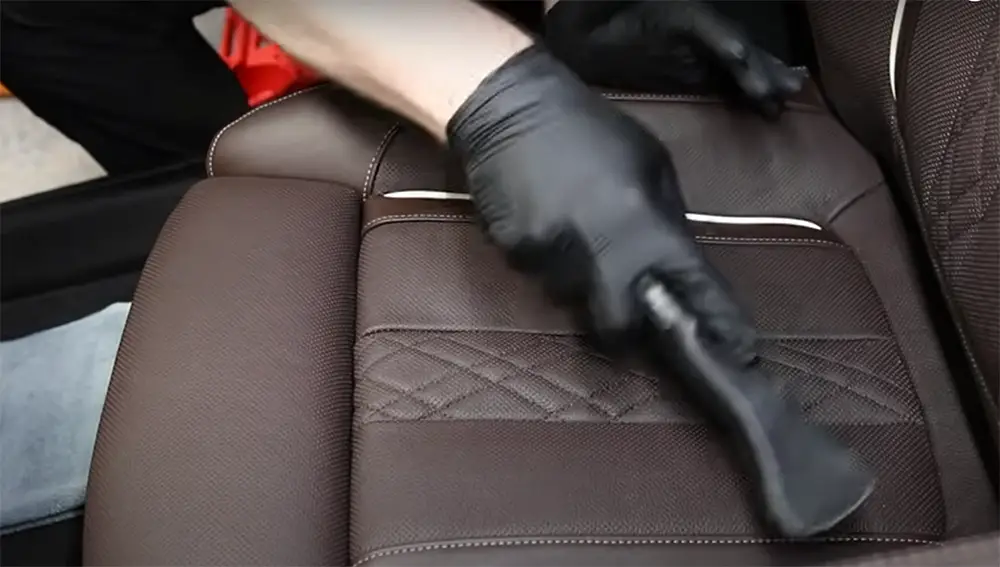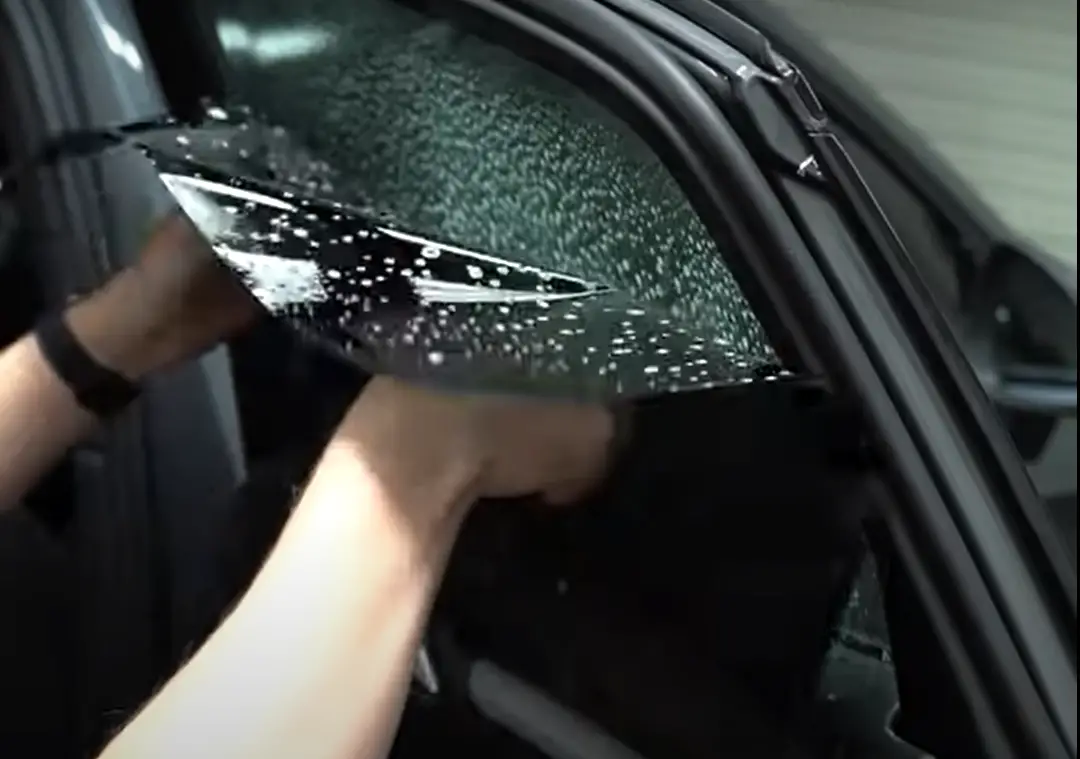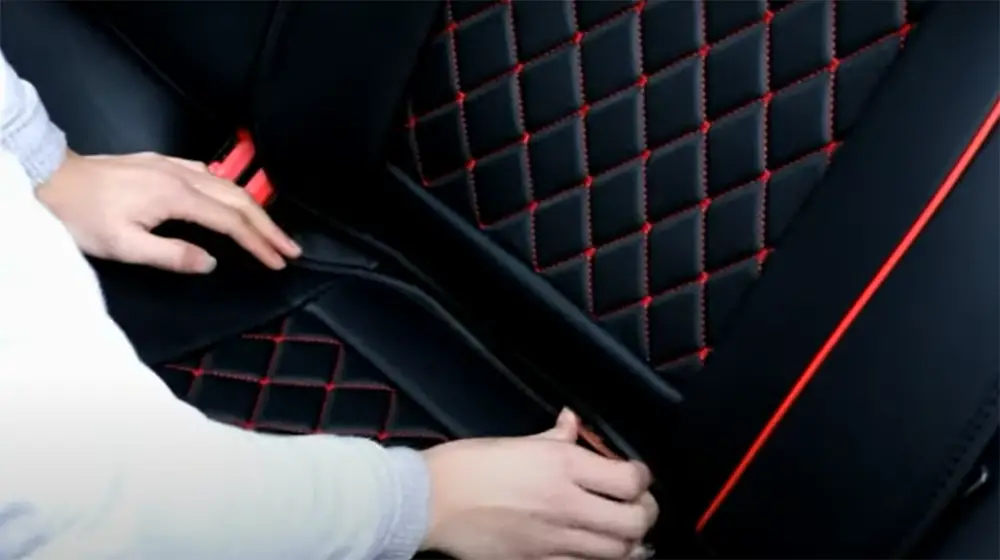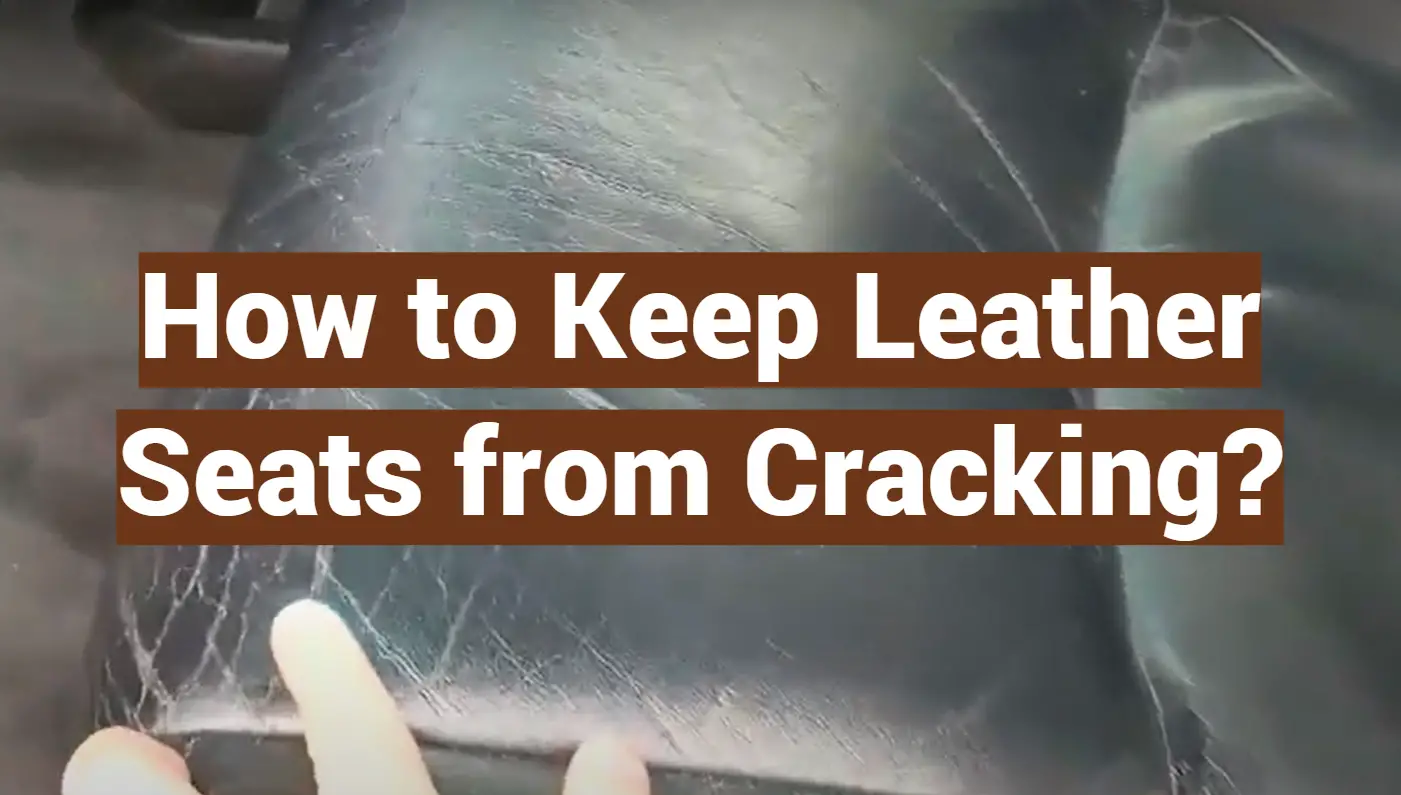The leather seats in your car are one of the most expensive features on it. The cost of replacing them can be very high, not to mention how much you will spend on new clothes for when they get messy after eating a meal while driving! What’s more, if you have kids or pets who like to rest their feet on the seat, then these people (or animals) could be inadvertently causing damage.
That is why you may want to check a few expert tips and tricks about how to keep leather seats from cracking so that you don’t have any problems down the road.
Things to Do for Keeping Leather Seats from Cracks:
1) Park in the shade when you can
The sun is one of the biggest culprits for leather cracking. If you can’t park in the shade, at least make sure your car isn’t parked in direct sunlight. If it’s hot and sunny outside, consider using a sunshade to keep your car from getting too hot. The seats will be grateful [1].

2) Crack open a window on hot days
When it’s hot outside, crack open a window to let some air in and help keep your seats cool.
3) Use a sunshade
Sunshades are available at most automotive stores. Be sure to get one that fits well so it doesn’t flap in the wind.
4) Clean your leather seats regularly
Leather needs to be cleaned and conditioned regularly to look its best.
You’ll want to clean the seats every few weeks with mild soap and water, then condition them regularly. Most car owners recommend doing this once per month if you live in an area that’s prone to high heat and humidity (or rain). Be sure to use only approved products on your car! Oils from foods like cheese, steak, fish & chicken will stain leather over time making it look dirty. Don’t eat food while sitting on the seats!

Also, a good leather cleaner and conditioner can be bought at any automotive store. Be sure to follow the instructions on the bottle carefully.
5) Install seat covers
If you’re not up for cleaning your leather seats every few weeks, consider installing seat covers. This will protect your seats from UV effects, cracks, spills, dirt, and other debris. There are many different types and styles of seat covers available, so be sure to find ones that fit your car and lifestyle.
6) Tint your windows
Window tinting will help keep the interior of your car cooler, and in turn, help keep your leather seats from cracking.

7) Vacuum with a soft bristle attachment
Regular vacuuming using a soft bristle attachment will help keep the dirt and dust off your leather seats. This will also help condition the leather over time.
8) Keep sharp objects off the seats
Don’t put sharp objects on your seats. If you have to, place a towel or blanket over them first. This way if anything spills onto the seat it won’t penetrate right through and stain the leather permanently (like coffee).
Bonus: sharp things like umbrellas should be stored in an umbrella holder that attaches securely to the door frame so they don’t poke through from behind into your backseat passengers!
Comparison of Indicators for Preventing Cracking of Leather Seats
Leather seats add a touch of elegance and luxury to any vehicle. However, without proper care, they can develop cracks over time, detracting from their beauty and reducing their lifespan. To help you keep your leather seats in pristine condition, we have compiled a table comparing various indicators for preventing cracking.
Below is a comparison of different factors and their importance in maintaining the quality and longevity of leather seats. The table provides useful information to guide you in adopting the best practices for leather seat care.
| Indicator | Description | Importance |
|---|---|---|
| Regular Cleaning | Regularly clean leather seats to remove dirt, dust, and oils that can weaken the leather and cause cracking. | High |
| Conditioning | Applying a leather conditioner helps to moisturize and nourish the leather, preventing it from becoming dry and brittle. | High |
| Protection from Sunlight | UV rays can cause leather to fade and crack. Use sunshades or park in shaded areas to protect leather seats from direct sunlight. | Medium |
| Temperature and Humidity Control | Extreme temperatures and high humidity can accelerate leather deterioration. Maintain a moderate environment to preserve leather quality. | Medium |
| Preventing Sharp Objects | Avoid placing sharp or pointed objects on leather seats to prevent scratches, punctures, and potential cracks. | Low |
| Regular Inspection | Regularly inspect leather seats for signs of wear or damage. Timely repairs can prevent minor issues from developing into major cracks. | Low |
Explanation to the table:
- Regular Cleaning: Regularly cleaning leather seats helps remove dirt, dust, and oils that can weaken the leather fibers over time. This indicator is considered highly important in maintaining leather seat quality.
- Conditioning: Applying a leather conditioner moisturizes and nourishes the leather, preventing it from drying out and becoming brittle. Conditioning is another crucial step in preventing cracking and is of high importance.
- Protection from Sunlight: Exposure to direct sunlight can lead to leather fading and cracking. Protecting leather seats from harmful UV rays by using sunshades or parking in shaded areas is moderately important for preventing cracks.
- Temperature and Humidity Control: Extreme temperatures and high humidity levels can accelerate leather deterioration. Maintaining a moderate environment inside the vehicle helps preserve the quality of leather seats. This indicator holds medium importance.
- Preventing Sharp Objects: Placing sharp or pointed objects on leather seats can cause scratches, punctures, and potential cracks. While it is essential to avoid such objects, this indicator is considered of relatively low importance compared to other factors.
- Regular Inspection: Regularly inspecting leather seats for signs of wear or damage allows for timely repairs. Addressing minor issues promptly can prevent them from developing into major cracks. Although important, this indicator holds relatively low priority compared to the other factors.
By considering these indicators and implementing appropriate measures, you can significantly extend the lifespan of your leather seats and maintain their aesthetic appeal for years to come.
FAQ
Why are my leather car seats cracking?
When the leather car seats are cracked, the causes could be many. However, one of the most common reasons is that you have not cleaned your vehicle regularly or in an appropriate manner based on how heavy traffic conditions and climate changes affect it. The cracks can develop into holes due to continued use without cleaning and restoring them with a suitable conditioner product for them.
This will make driving difficult as there would be discomfort while sitting in certain positions or when prolonged pressure points like your hips or buttocks put too much stress on these areas of your seat cover which may eventually become permanently damaged
Proper maintenance of leather products helps keep their natural appearance longer than usual by avoiding exposure to harsh environmental elements such as direct sunlight and high temperatures.
How do you maintain leather car seats?
Genuine leather seats are susceptible to cracking. This is why you need a leather conditioner for your car’s interior, which will keep the material supple and hydrated. By regularly applying these products to your car’s upholstery, you can preserve its original appearance over time.
There are a few key things to keep in mind when caring for leather car seats [2]:

- Make sure to read the product instructions carefully, as some conditioners should not be used on light-colored leather;
- Avoid getting the conditioner near the seams of the seats, as it can make them brittle over time;
- Apply a small amount of conditioner to a soft cloth and gently rub it into the surface of the leather. Be sure to apply it evenly, and avoid using too much pressure, which could damage the material;
- Allow the conditioner to soak in before wiping off any excess with a clean cloth;
Leather is a beautiful and luxurious material that can add an extra touch of class to your car’s interior. By taking proper care of it, you can keep it looking its best for years to come. For more information on leather car seat maintenance, please consult your local auto dealer or online resources.
Do seat covers keep leather from cracking?
Leather seat covers can help to protect your car’s leather seats from cracking and fading. They are also a great way to keep your seats clean and free of dust, dirt, and other debris. There are a variety of different types and styles of leather seat covers available on the market, so be sure to select the right one for your vehicle.
Installation of leather seat covers is usually a simple process, and they can be easily removed for cleaning. When choosing a set of seat covers, make sure to select one that is made from high-quality materials and fits your car’s seats snugly.
How can I make my leather seats soft again?
Here is how you can make it [3]:
- Clean the entire seat surface completely. Rub a liquid leather cleaner such as those available at your local auto store over the whole leather surface. Make sure to clean out all of the nooks and crannies in the seat. Allow the leather cleaner to sit for a few minutes on the seat before wiping it away with a paper towel or clean cloth to ensure that no excess remains;
- Fill a clean cloth with water and then saddle soap. Using the cloth, create a good foam before carefully working the saddle soap into the seat leather surface. Again, make sure you get down into all of the tiny nooks and crannies in the seat. Concentrate on any areas that are dry, cracked, or otherwise damaged to ensure that they are properly cared for;
- Check the color code for your car’s seats by examining the label on the inside of the driver’s side door. Many manufacturers include important information such as paint codes, interior codes, and seat color codes in this location;
- Apply the color restorer liberally to the seats and rub it in. Wipe away any excess with a paper towel or clean cloth if necessary;
- If the seats are black in color, use mink oil on them. Because mink oil may stain leather, it should not be used on light-colored car seats. Mink oil will make the leather darker and softer overtime, so apply it periodically to keep it from getting wet and becoming damaged;
How do you repair cracked leather?
If the leather is cracked but not broken, you can try to repair it with a commercial leather patch or sealant. First, clean the area around the crack with a mild soap and water solution. Dry the area completely, then apply the leather patch or sealant according to the manufacturer’s instructions.
If the leather is broken, you will need to replace it. Consult a professional upholsterer for advice on how to do this.
One way to help keep your leather seats from cracking is to condition them regularly. There are many different types of leather conditioners available at auto parts stores or online. Choose one that is made specifically for automotive use.
Use a soft cloth to apply the conditioner, then wipe off the excess with another dampened cloth. Allow the leather to dry completely before using it again. Repeat this process once every six months or so. You will be able to keep your automotive leather looking brand new for years to come if you take proper care of it!
How do you restore dry leather car seats?
If your leather car seats are dry, it’s time to restore them. You can do this by using a commercial leather cleaner and conditioner or you may choose to use products that you already have around the house such as saddle soap and mink oil (make sure they’re not scented).
Use a soft cloth or sponge when cleaning. Avoid abrasive cleaners like those made with alcohol. After wiping down the area, apply the leather conditioner according to package instructions.
Allow all of these items sufficient time to soak in before buffing off excess product with another clean towel. Repeat this process every 6 months for the best results!
Is lanolin good for leather car seats?
Linen can be a wonderful moisturizer, but it softens leathers more than an over-the-counter brand-name leather conditioner. This may be acceptable in certain instances, such as jackets, shoes, and wallets. Many individuals prefer their leather to feel hard and rough [4].
Does heat make leather crack?
It heats up leather, which dries it out. The drying process can damage the leather and make cracks more prominent. Leather is a natural material that comes from animal skin. It has pores, just like human skin does. Heat expands these pores and causes them to stretch beyond their limits; when the air cools down again, the leather shrinks back into its original shape with all of those stretched-out features still present.
The heat also breaks apart some of the chemical bonds in proteins found within cowhide so they become brittle and weak instead of flexible. As you continue to apply heat without applying any moisturizer or conditioner, your seat will develop permanent creases because nothing increases flexibility.
Other materials that heat up include plastic, vinyl, and rubber – all of which are commonly used to make car interiors. Leather is more delicate than these items so it does not fare well under the same extreme temperatures.
Can you put Armor All on leather?
Leather Wipes from Armor-All can be used on almost every leather surface, including treated leather furniture, apparel, and automobile seats. Their specially developed cleaners help to keep your leather looking new whether in your car or at home [5].
Can Murphy Oil Soap be used on leather?
You may use Murphy Oil Soap as a leather conditioner on your automobile’s dashboard or upholstery (not cloth), and it would also work well on leather furniture. Work the substance evenly over the region, then buff it with a clean towel [6].
How can I make my leather seats look new?
Use a leather cleaner and conditioner to restore that new-car look. Clean your car’s seat by sponging it with warm water, then use the mildest soap you can find followed by a thorough rinsing of clean water.
After drying off any excess moisture from the seats (this is important), apply some sort of leather conditioner using an applicator sponge or soft cloth. You may also purchase what is known as “leather dressing” at most auto parts stores.
It might take several applications overtime to get all the way down into older cracks and fill them in completely. Continue this process until you have achieved optimum results for your specific vehicle.
What causes leather seats to crack?
Leather seats can crack due to various factors such as excessive dryness, UV exposure, improper maintenance, harsh cleaning agents, and lack of conditioning. These factors contribute to the loss of natural oils and moisture in the leather, making it brittle and prone to cracking.
How can I prevent leather seats from cracking?
To keep leather seats from cracking, you can follow these preventive measures:
- Regularly clean your leather seats with a pH-balanced leather cleaner to remove dirt and oils that can degrade the leather.
- Apply a high-quality leather conditioner at least every three months to restore moisture and replenish the natural oils in the leather.
- Keep your vehicle out of direct sunlight or use window shades to minimize UV exposure, as it can accelerate leather deterioration.
- Avoid using harsh chemical cleaners or products containing alcohol, ammonia, or bleach, as they can strip the leather of its natural oils and cause it to crack.
- Use a leather protectant or conditioner with UV inhibitors to provide an additional layer of protection against sun damage.
What is the best way to clean leather seats?
The best way to clean leather seats is by following these steps:
- Start by vacuuming the seats to remove any loose dirt and debris.
- Wipe the seats with a damp microfiber cloth or sponge using a mild leather cleaner. Make sure the cleaner is pH-balanced and specifically designed for leather.
- Gently scrub the leather in a circular motion to lift any embedded dirt or stains.
- Rinse the cloth or sponge and wipe away the cleaning residue.
- Dry the seats with a clean, dry cloth.
- After cleaning, apply a leather conditioner to moisturize and protect the leather.
Should I use a specific type of conditioner for leather seats?
Yes, it is recommended to use a conditioner specifically formulated for leather seats. Look for a high-quality leather conditioner that contains natural oils and moisturizers to replenish the leather’s lost oils and prevent cracking. Avoid conditioners with silicone or petroleum-based ingredients, as they can cause long-term damage to the leather.
How often should I apply a conditioner to my leather seats?
It is generally recommended to apply a leather conditioner to your seats at least every three months. However, the frequency may vary depending on the specific type of leather, climate conditions, and usage. If your leather seats are exposed to excessive sunlight, dry air, or heavy use, you may need to condition them more frequently to maintain their suppleness and prevent cracking.
Can I use household products like olive oil to condition leather seats?
No, it is not advisable to use household products like olive oil to condition leather seats. While olive oil may temporarily moisturize the leather, it can also lead to long-term damage and discoloration. Household products are not specifically formulated for leather care and may contain substances that can harm the leather’s natural properties. It is best to use products specifically designed for conditioning leather seats.
Useful Video: How To Prevent Leather Cracks – Chemical Guys Car Care
References:
- https://www.sundevilauto.com/how-to-keep-your-cars-leather-seats-from-cracking
- https://www.banisters.com/how-to-prevent-auto-interior-leather-from-cracking-in-the-winter
- https://itstillruns.com/soften-stiff-leather-car-seats-5959764.html
- https://www.galenleather.com/blogs/news/leather-conditioning
- https://www.armorall.com/expert-tips/faqs/interior-faqs
- https://www.murphyoilsoap.com/murphy-home-care/murphy-oil-soap-uses







Leave a Reply